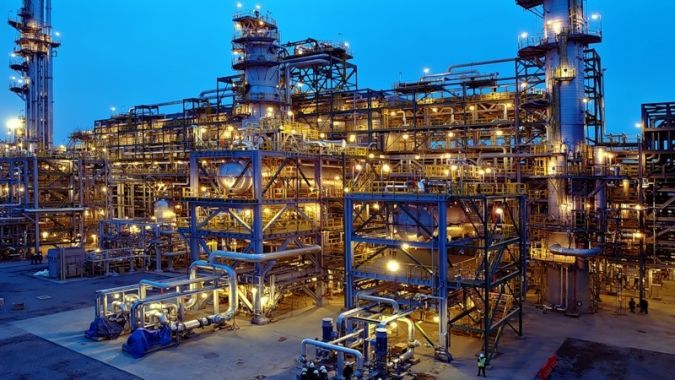By Laura SULEIMENOVA
 Three TCO facilities -- KTL, SGP and SGI -- stopped at once on January 3 after power outage at Tengiz field.
Three TCO facilities -- KTL, SGP and SGI -- stopped at once on January 3 after power outage at Tengiz field.
The accident was eliminated quickly, yet questions to the company still remain.
Who is the guilty?
TCO partially admitted the guilt putting the greater part of responsibility on KEGOC, national grid operator, which in response denied the accusations -- they believe the accident occurred owing to process failures at TCO facilities.
Gostekhnadzor [State Energy Supervision and Control Committee] confirmed the statement of national operator adding that TCO gas turbine power stations did not have passports of readiness for heating season.
Lessons of 2005
Increasingly frequent incidents at Tengiz demonstrate that production "kingdom" of the oil giant now has serious problems.
Looking back to July 2, 2005, the whole technologic process at plant stopped for 24 hours in similar circumstances [failure in power network]. Over 7,000 of personnel involved in the construction of second generation plant [SGP] were evacuated.
Two criminal proceedings were launched for violation of environmental regulations during operations and air contamination with damage to people's health.
According to Ak Zhaik, nearly 200 people applied to TCO clinic that day, but Tengizchevroil and state bodies diligently denied this fact claiming only three persons had suffered from H2S.
Reportedly, 34,000 cubic meters of pollutants were discharged to the air after the emergency stoppage that day, not 23,000 initially stated by TCO. Damage from the latest accident must be no less.
In 2005 TCO alleged objective factors while state emergency officers claimed it was a human factor, in other words - mismanagement of power supply system.
Slender thread
Besides power supply failures the reason could also be water supply problems -- there are no alternative sources of water.
After the recent public hearings on TCO's 2012 nature protection action plan Aarhus center referred questions to the company but received out-of-subject answers.
"What will the company do [is there a plan] if accident happens at Kigach-Uzen water pipeline?"
The environmentalists worry that from water shortage at plant, problems may emerge in cooling of equipment. As we know, there is no recycling water supply at Tengiz. Or, rather they just started thinking of it before the 20th marking of oil production.
TCO gave a simple answer: in case of an accident "as the first thing the waterline should be repaired and put into operation again." There is no alternative options of water supply in case of such an accident. It means the largest oil production fully depends on the only waterline.
Restoration-like repair
Incidents [various emergency stoppages] quite often take place at Tengiz. This, of course, is one of the causes for reduction of crude production in the past few years.
Officially, the reduction in 2012 is connected with the scheduled turnaround at production sites of SGP/SGI in August-September [42 days].
In that period, TCO maintained production rate by having its five production lines operating at a maximum mode, what means shareholders did not want to bear losses during turnaround.
In private conversations, the company employees call the latest repair works "rather restoration of plant in order to pump as much oil as possible within the shortest time."
The reason for frequent failures, breakdowns and consequent idle-stands is overloading of equipment and its depreciation. To change all the equipment is expensive both money and time wise.
True target of 2012 turnaround [which is more like a restoration] is to load SGP to the maximum extent. The facility was initially designed for a certain capacity [less than today] and after the turnaround it's now experiencing a greater load. That's why accidents happen.
Imperial crown
Another possible reason for process failures is high diversion of experienced employees from TCO to other companies due to non-competitive salaries and lack of career opportunities. Maybe that's why despite "pump out as much as possible and save" efforts, the company's revenues go down despite high crude prices in the world market.
According to KazMunayGas development strategy for 2012-2022 net profit of TCO in 2012 was forecasted to be $8.6bn, while in 2011 the figure was $10.4bn. In total TCO planned to receive $23.5bn in 2012 against $25.3bn in 2011. Payments to Kazakhstan's budget in 2012 amounted $10.1bn, while in 2011 it was $11.4bn.
As said Serikzhan MAMBETALIN, an expert of Russia's Save Caspian Sea Foundation, in an interview to Forbes-Kazakhstan, one must think twice before he believes the information the company provides for Kazakhstan:
- Recently, TCO announced its overall revenue in 1993-2012 was $128bn and payments to Kazakhstan's budget in this period amount $47bn. For oil companies tax rate is between 65% and 80%. Here they state one price for oil and then take it to Chevron plants. If we look at retail prices of benzene or diesel they sell, their margin is crazy. For a reason Chevron people call Tengiz "a diamond in Chevron's crown."
Apparently, the diamond's price is now going down thanks to great appetites of its owners.
"The largest diamond in the imperial crown of Chevron is Tengiz, which is the natural wealth of Kazakhstan, not TCO," says Makhambet KHAKIMOV, the head of NGO Kaspi Tabigaty.
"It can be safely developed over the 21st century in an environmentally friendly way with annual production of not more than 15mln tons" recommends Mouftakh DIAROV, the academician.
But no one cares about the future seeing billions at stake.
 В Атырау -6
В Атырау -6